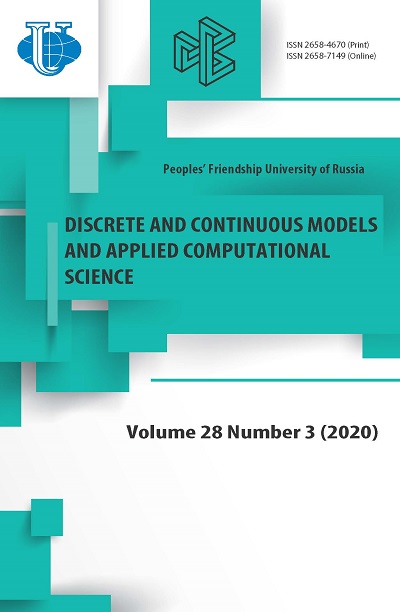On the rate of convergence for a class of Markovian queues with group services
- Authors: Kryukova A.L.1
-
Affiliations:
- Vologda State University
- Issue: Vol 28, No 3 (2020)
- Pages: 205-215
- Section: Articles
- URL: https://journals.rudn.ru/miph/article/view/24702
- DOI: https://doi.org/10.22363/2658-4670-2020-28-3-205-215
- ID: 24702
Cite item
Full Text
Abstract
There are many queuing systems that accept single arrivals, accumulate them and service only as a group. Examples of such systems exist in various areas of human life, from traffic of transport to processing requests on a computer network. Therefore, our study is actual. In this paper some class of finite Markovian queueing models with single arrivals and group services are studied. We considered the forward Kolmogorov system for corresponding class of Markov chains. The method of obtaining bounds of convergence on the rate via the notion of the logarithmic norm of a linear operator function is not applicable here. This approach gives sharp bounds for the situation of essentially non-negative matrix of the corresponding system, but in our case it does not hold. Here we use the method of ‘differential inequalities’ to obtaining bounds on the rate of convergence to the limiting characteristics for the class of finite Markovian queueing models. We obtain bounds on the rate of convergence and compute the limiting characteristics for a specific non-stationary model too. Note the results can be successfully applied for modeling complex biological systems with possible single births and deaths of a group of particles.
Full Text
Introduction Consider a Markovian queueing model on the finite state space {0, 1, … ,
- Srinivasan et al., “
About the authors
Anastasia L. Kryukova
Vologda State University
Author for correspondence.
Email: kryukovaforstudents@gmail.com
Lecturer of Department of Applied Mathematics
15, Lenina St., Vologda, 160000, Russian FederationReferences
- R. Nelson, D. Towsley, and A. N. Tantawi, “Performance analysis of parallel processing systems,” IEEE Transactions on Software Engineering, vol. 14, no. 4, pp. 532–540, 1988. doi: 10.1109/32.4676.
- J. Li and L. Zhang, “MX /M /c Queue with catastrophes and statedependent control at idle time,” Frontiers of Mathematics in China, vol. 12, no. 6, pp. 1427–1439, 2017. doi: 10.1007/s11464-017-0674-8.
- A. Zeifman, R. Razumchik, Y. Satin, K. Kiseleva, A. Korotysheva, and V. Korolev, “Bounds on the rate of convergence for one class of inhomogeneous Markovian queueing models with possible batch arrivals and services,” International Journal of Applied Mathematics and Computer Science, vol. 28, pp. 141–154, 2018. doi: 10.2478/amcs-2018-0011.
- A. Zeifman, A. Sipin, V. Korolev, G. Shilova, K. Kiseleva, A. Korotysheva, and Y. Satin, “On Sharp Bounds on the Rate of Convergence for Finite Continuous-time Markovian Queueing Models,” in Computer Aided Systems Theory — EUROCAST 2017. EUROCAST 2017. Lecture Notes in Computer Science, R. Moreno-Díaz, F. Pichler, and A. Quesada-Arencibia, Eds., vol. 10672, 2018, pp. 20–28. doi: 10.1007/978-3-319-74727-9_3.
- A. Zeifman, Y. Satin, A. Kryukova, R. Razumchik, K. Kiseleva, and G. Shilova, “On the Three Methods for Bounding the Rate of Convergence for some Continuous-time Markov Chains,” International Journal of Applied Mathematics and Computer Science, vol. 30, pp. 251–266, 2020. doi: 10.34768/amcs-2020-0020.
- Y. Satin, A. Zeifman, and A. Kryukova, “On the Rate of Convergence and Limiting Characteristics for a Nonstationary Queueing Model,” Mathematics, vol. 7, no. 678, pp. 1–11, 2019. doi: 10.3390/math7080678.
- B. Almasi, J. Roszik, and J. Sztrik, “Homogeneous finite-source retrial queues with server subject to breakdowns and repairs,” Mathematical and Computer Modelling, vol. 42, no. 5, pp. 673–682, 2005. DOI: 10. 1016/j.mcm.2004.02.046.
- A. Brugno, C. D’Apice, A. Dudin, and R. Manzo, “Analysis of an MAP /PH/1 queue with flexible group service,” International Journal of Applied Mathematics and Computer Science, vol. 27, no. 1, pp. 119–131, 2017. doi: 10.1515/amcs-2017-0009.
- A. Di Crescenzo, V. Giorno, B. K. Kumar, and A. Nobile, “A Time-Non-Homogeneous Double-Ended Queue with Failures and Repairs and Its Continuous Approximation,” Mathematics, vol. 6, no. 5, p. 81, 2018. doi: 10.3390/math6050081.
- A. N. V. Giorno and S. Spina, “On some time non-homogeneous queueing systems with catastrophes,” Applied Mathematics and Computation, vol. 245, pp. 220–234, 2014. doi: 10.1016/j.amc.2014.07.076.
- B. Granovsky and A. Zeifman, “Nonstationary Queues: Estimation of the Rate of Convergence,” Queueing Systems, vol. 46, pp. 363–388, 2004. doi: 10.1023/B:QUES.0000027991.19758.b4.
- H. LI, Q. Zhao, and Z. Yang, “Reliability Modeling of Fault Tolerant Control Systems,” International Journal of Applied Mathematics and Computer Science, vol. 17, no. 4, pp. 491–504, 2007. doi: 10.2478/v10006-007-0041-0.
- A. Moiseev and A. Nazarov, “Queueing network MAP − (GI/∞)K with high-rate arrivals,” European Journal of Operational Research, vol. 254, no. 1, pp. 161–168, 2016. doi: 10.1016/j.ejor.2016.04.011.
- J. Schwarz, G. Selinka, and R. Stolletz, “Performance analysis of time-dependent queueing systems: Survey and classification,” Omega, vol. 63, pp. 170–189, 2016. doi: 10.1016/j.omega.2015.10.013.
- N. Vvedenskaya, A. Logachov, Y. Suhov, and A. Yambartsev, “A Local Large Deviation Principle for Inhomogeneous Birth-Death Processes,” Problems of Information Transmission, vol. 54, no. 3, pp. 263–280, 2018. doi: 10.1134/S0032946018030067.
- A. Zeifman, S. Leorato, E. Orsingher, Y. Satin, and G. Shilova, “Some universal limits for nonhomogeneous birth and death processes,” Queueing Systems, vol. 52, no. 2, pp. 139–151, 2006. doi: 10.1007/s11134-006-4353-9.
- A. Zeifman, V. Korolev, Y. Satin, A. Korotysheva, and V. Bening, “Perturbation Bounds and Truncations for a Class of Markovian Queues,” Queueing Systems, vol. 76, no. 2, pp. 205–221, 2014. doi: 10.1007/s11134-013-9388-0.
Supplementary files















